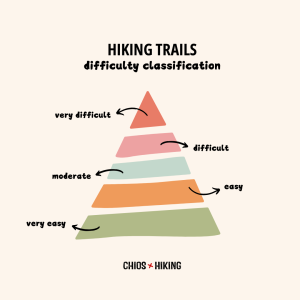H iking is an activity that connects people with nature, offering immersive experiences and opportunities for rejuvenation. Choosing the right trail is crucial for both the enjoyment and safety of every hiker. Categorizing trails based on their difficulty helps hikers select routes that match their physical abilities and experience levels.
The difficulty of a trail is determined by factors such as elevation gain, terrain type, trail length, ease of access, and the quality of signage. Weather conditions also play a significant role, as they can impact both safety and the overall experience.
More specifically, trails with substantial elevation changes or long distances require greater physical endurance, while technical difficulty depends on the steepness, terrain type, and potential obstacles along the way. Clear and reliable signage minimizes the risk of getting lost, facilitates navigation, and enhances hiker safety.
Globally, various systems classify trails by difficulty. Of particular interest is the IBP index (Intelligent Benchmark Prediction), which estimates the effort required to complete a trail by considering technical parameters and the hiker’s physical condition.
In Greece, a ministerial decision (Government Gazette 206/B/30-01-2017) introduces four main trail categories: Easy, Moderate, Difficult, and Very Difficult. At Chios Hiking, we’ve taken it a step further, dividing the “Easy” category into “Very Easy” and “Easy” to better reflect the characteristics of trails on Chios and provide more precise descriptions.

Here is the classification we use:
Very Easy: Safe, wide trails with gentle slopes and a length of up to 5 km (3.1 miles). Suitable for children and adults of all fitness levels and experience.
Easy: Safe trails with mild slopes for most of their length, which can exceed 5 km. Ideal for adults and children with moderate fitness levels, regardless of experience.
Moderate: Trails with some steep sections (uphill/downhill), limited narrow or rough terrain, and a maximum length of 10 km (6.2 miles). Require moderate to good physical fitness and some experience.
Difficult: Trails with rough, slippery, narrow, or steep terrain, significant elevation gain, and a length that can exceed 10 km. Suitable for hikers with good to very good fitness levels and relevant experience.
Very Difficult: Trails with the same characteristics as the “Difficult” category but requiring the use of hands for progress. Designed for experienced adults with technical skills and excellent physical fitness.
It should be noted that the boundaries between categories are not absolute, as these classifications are not rigid. For example, a trail with a slight incline in only a very small section may be classified in a lower category, even if the incline in that particular spot suggests a higher category. Additionally, the difficulty level of a trail can change over time. Proper maintenance of a route can reduce its difficulty, while neglect may make it more challenging.
Nevertheless, trail categorization remains a valuable tool for hikers, helping them choose routes that align with their abilities and preferences. At Chios Hiking, we place great emphasis on providing accurate and reliable information about trails and their difficulty levels, ensuring that every hike is a safe and enjoyable experience in nature.